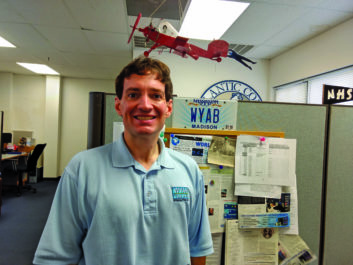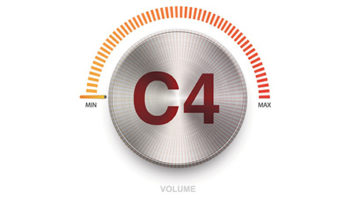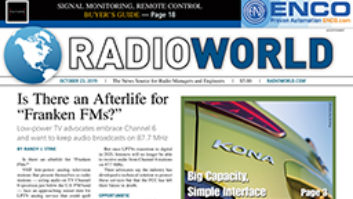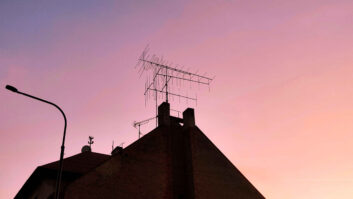
The author is CEO of SSR Communications, owner of WYAB(FM) in central Mississippi.
A proceeding currently before the Federal Communications Commission to provide eligible Zone II Class A commercial FM broadcasters an opportunity to upgrade from 6 kilowatts to 12 kilowatts has not attracted a great number of headlines this year, but that has not prevented the FM Class C4 proposal from making some significant strides as of late.
Most noteworthy, the Class C4 FM idea has attracted some powerful allies. In January, the proposal won the backing of the Sen. Roger Wicker of Mississippi, sitting chairman of the U.S. Senate Committee on Commerce, Science, and Transportation, the Congressional body that maintains direct oversight over the FCC. Sen. Wicker noted that the power increase could be of particular benefit to “small and rural radio stations” in a letter to FCC Chairman Ajit Pai. In his February, 2019 reply, Chairman Pai agreed by saying that the FM Class C4 option “could be especially important for small, minority-owned stations that currently cannot serve their entire communities.”
Sen. Wicker now joins the list of approximately 130 small broadcasters who filed comments in full support during the FM Class C4 Notice of Inquiry (MB 18-184, FCC 18-69) filing windows in September, 2018. Several years prior, FCC Chairman Ajit Pai first advocated for the new station class in September, 2016 at the NAB/RAB Radio Show in Nashville, Tenn., and going back further, the Multicultural Media, Telecom and Internet Council (MMTC) supported the effort in 2013 when it helped author the original proposal.
[Read: Where Things Stand for FM Class C4: the Waiver Route]
Predictably, a turf war has erupted between the small broadcasters that the FM Class C4 proposal would benefit, and larger license holders who generally control the biggest signals in any given market. The National Association of Broadcasters did not support the introduction of a new station class, which is unsurprising, as that same organization vehemently opposed the creation of the FM Class C0 allotment type some 20 years earlier. Although larger companies stopped short of endorsing the idea fully, some nationwide broadcasters did come out in support of the FM Class C4 concept, including Educational Media Foundation, while iHeartMedia did not oppose the new station class in its comments.
The current sticking point in the FM Class C4 proceeding appears to stem from a component of the proposal that would give certain underbuilt Section 73.207-licensed stations a Section 73.215 designation, provided that the affected station has operated under its maximum antenna height, power level, or equivalent thereof, for a period of ten years or more. Under the current FCC rules, a neighboring station looking to upgrade that is adjacent to an underbuilt Section 73.207-licensed station must treat that station as if it were fully built out, whereas a Section 73.215 station can be protected assuming its actual antenna height and power level.
The practice of treating underbuilt stations as if they were fully constructed can have large implications for smaller adjacent stations wanting to upgrade in power or situate their antenna sites more favorably. For example, a full FM Class C1 station is able to broadcast with 100 kilowatts of power from an antenna height above average terrain of 299 meters. If that station were to have an antenna height of only 200 meters above average terrain, then its primary service contour would be about 5 miles short of what a fully built FM Class C1 facility could reach. Any competing neighboring station looking to upgrade is compelled to protect that underbuilt station for five extra miles of coverage that it does not (or if underbuilt for more than 10 years, likely will not ever) serve.
In August, 2019, SSR Communications Inc., which co-authored the FM Class C4 petition with MMTC, presented a revised version of the Section 73.215 aspect of the proposal to the FCC’s Audio Division. The amended plan would still call for redesignation of certain underbuilt Section 73.207 licensed stations as Section 73.215 authorizations, but would also provide a 3 dB protective “buffer zone” to allow the affected stations an opportunity to relocate or build out more fully in the future. The buffer zone would create a protective bubble around underbuilt stations, usually amounting to anywhere from 3 to7 miles, depending on how severely underpowered or under-height the affected station may be.
This 3 dB buffer zone “compromise” would resolve the controversial aspects of the FM Class C4 proposal and should allow the proposal to advance. The buffer eliminates almost all scenarios in which an affected reclassified Section 73.215 facility could be hemmed in and blocked from making future service improvements or tower relocations. It would also disincentivize the Section 73.215 conference procedure for stations seeking such towards neighboring underbuilt Section 73.207 facilities in almost all cases, except for those involving Section 73.207 stations that are the most decidedly underbuilt with respect to their class. Indirectly, the buffer prevents almost any scenario in which a secondary service could be affected by the Section 73.215 component of the FM Class C4 idea.
Meanwhile, an alternative waiver-based path towards a FM Class C4 equivalent facility may also soon exist. In July, 2018, WRTM(FM) 100.5 MHz asked the Federal Communications Commission to consider allowing the station to double in power from 6 kilowatts to 12 kilowatts. If granted, the WRTM waiver application would establish new precedent and provide certain Class A FM stations an opportunity to enjoy an improvement in coverage.
Unlike the FM Class C4 proposal, the WRTM application (BPH-20180716AAC) suggests that, in order to double in power, a Class A FM licensee should guarantee that its upgraded signal would not impact vital LPFM and FM translator services. Also departing from the Class C4 FM proceeding is the idea that a neighboring Section 73.207-licensed station could still be reclassified as a Section 73.215 facility if it is not built out fully, but only if that station has been operating below its antenna height or maximum power level for a period of 30 years (the FM Class C4 proposal states that a 10-year window is appropriate). The WRTM filing backs this argument by saying, “No zoning problem, FAA issue, or cost consideration could not be resolved within 30 years if the desire is truly there to build out fully.”
Whether moving forward “as is,” as an amended proposal with a 3 dB buffer zone consideration, as a waiver-based procedure for eligible stations, or something else altogether, what will happen next in the FM Class C4 proceeding is anyone’s guess. What is clear is, however, that hundreds of FM Class A stations would be able to double in power and would gladly do so if given such an opportunity. With support in high places, it seems as if a breakthrough is just around the corner, and it could be sooner than later that the FM Class C4 idea moves from concept to reality.
Radio World invites industry-oriented commentaries and responses. Send to Radio World.
[Subscribe to our newsletter and get it delivered right to your inbox.]







